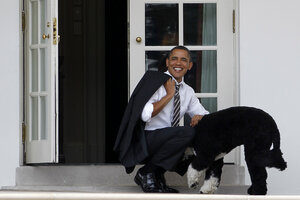Obama Romney dog wars: cultural lessons for the dinner table
"Obama eats dog!" "Romney cages dog on car roof!" Wipe away the political rhetoric and the dog wars is a great dinner table topic about different cultures.

We woke up today to a President Obama dog controversy that we think, well, shouldn't really be a controversy at all. Here the president is in March 2012 with First Dog Bo. We say the Romney-Obama dog wars are a chance to talk to kids about the big, beautiful world.
Pablo Martinez Monsivais/AP
Oh, the teachable moments that are coming out of the 2012 presidential campaign. Forget the mommy wars. Forget health care, the economy and taxes - today we have the President Barack Obama dog controversy and the Mitt Romney versus Obama dog wars.
Can’t wait to explain this one to the kiddos. Nothing like headlines that scream “Obama eats dog!” to start a conversation at the breakfast table. (And make the family pooch a bit nervous.)
But swipe away some of the hot political rhetoric and there actually are some lessons – non partisan ones – to talk about with kids.
To recap, the current twist in the War on Dogs comes after a long time criticism of a revelation, first reported in 2007, that on a 12-hour drive from Massachusetts to Canada in 1983, the Romney family put their dog, an Irish Setter named Seamus, in a crate on the top of their car. It was the only thing to do, they explained, because with all those kids there wasn’t any room in coach.
The dog lovers went a bit nuts. Because, well, you just can’t do that. (My husband, however, upon hearing this said he thought the top-of-car-crate was a great idea. But don’t worry, PETA. Not gonna happen. The dog was here first.)
And the Dems haven’t been able to resist – tweeting out photos of Obama and First Dog Bo, with some requisite snarky comments about how good dog-owners act. (Rick Santorum – who was fighting Romney to be Republican nominee and had his own problems with seating space – was happy to bring it up, as well.)
So it was inevitable, really, that the conservatives would eventually jump on this passage of Obama’s memoir, “Dreams From My Father.”
With Lolo, I learned how to eat small green chill peppers raw with dinner (plenty of rice), and, away from the dinner table, I was introduced to dog meat (tough), snake meat (tougher), and roasted grasshopper (crunchy). Like many Indonesians, Lolo followed a brand of Islam that could make room for the remnants of more ancient animist and Hindu faiths. He explained that a man took on the powers of whatever he ate: One day soon, he promised, he would bring home a piece of tiger meat for us to share.
Look, everyone! They said. Obama eats dog!
Bound to attract attention in the under-13 set.
So parents, maybe this is a good time to talk about cultural difference. (And, perhaps, about how families with a bazillion kids just try to do what they can to make things work. I mean, I personally think the top of the car thing is a bit nuts, but at least the Romneys wanted Seamus with them, right?)
The Indonesians are not alone when it comes to eating dog meat. Although laws are changing in many places because of the growing status of dogs (and cats) in family life, dog meat has been pretty common in China, Hong Kong, South Korea, Vietnam, and even Switzerland. A century ago it was even more widespread, with dog a specialty in much of Europe.
Academics who study this sort of thing are interested in how dog meat has become such a taboo while most people think it’s just fine and dandy to eat other animals that have, by various tests, the same intelligence and emotion. (Pigs, for instance.) Many of the people who are outraged about "Obama eats dog" are the same people who will pooh-pooh vegetarians as Leftist softies.
But dogs are different, most people will say. They're our best friends. Family members.
But why? the academics ask. It’s really a pretty fascinating historical and sociological study.
Meanwhile, people from around the world eat lots of things that we don’t. In many of the countries where I’ve worked cane rat is a delicacy. Grasshoppers, too.
I could never bring myself to try either – the personal yuck factor was just too much – but I saw that as my problem.
The lesson, I believe? It’s a big, beautiful, fascinating world out there. People are different, and that’s OK.
Maybe that’s what we could talk to our kids about this morning.

